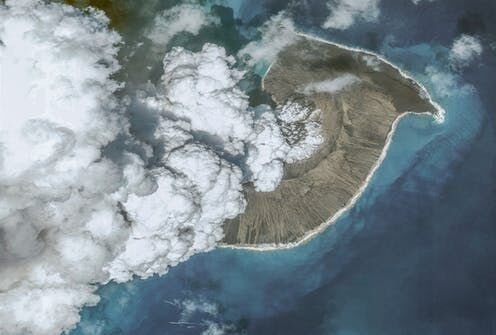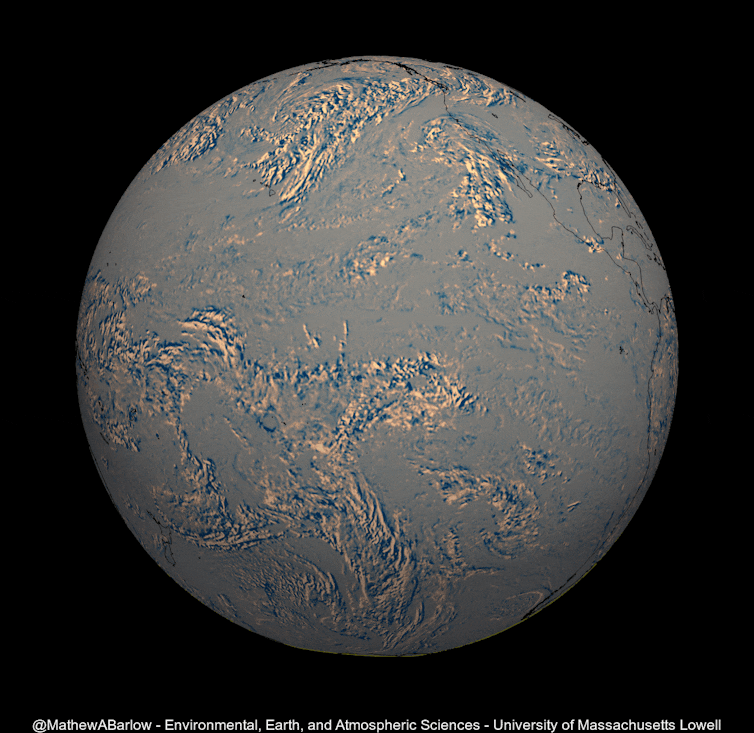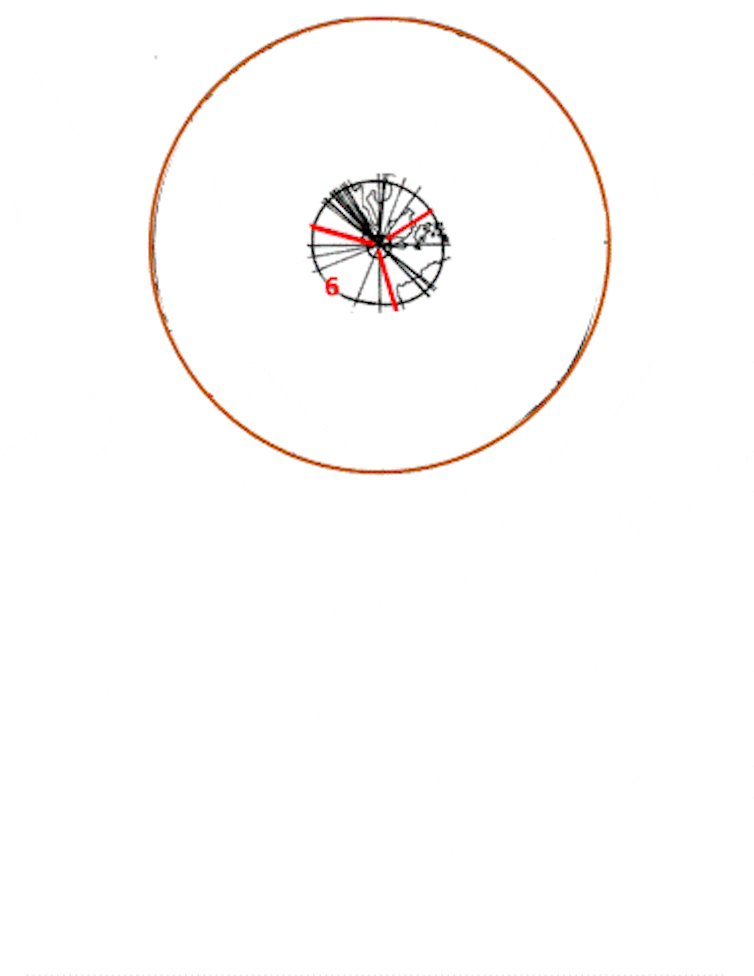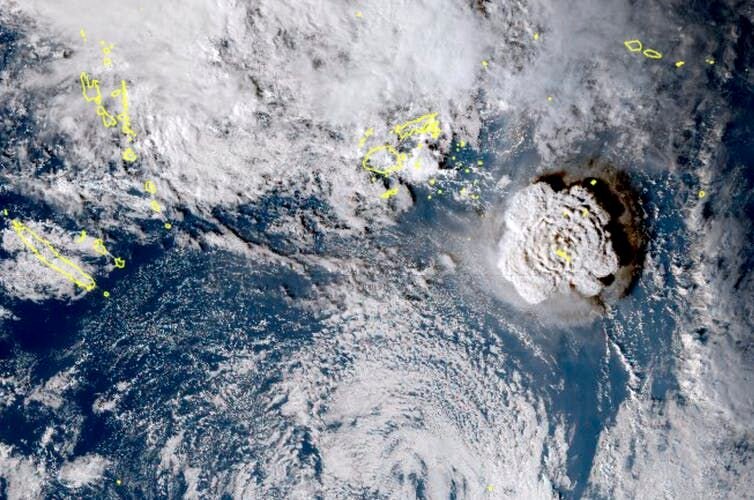
The Hunga Tonga-Hunga Ha’apai eruption reached an explosive crescendo on Jan. 15, 2022. Its rapid release of energy powered an ocean tsunami that caused damage as far away as the U.S. West Coast, but it also generated pressure waves in the atmosphere that quickly spread around the world.
The atmospheric wave pattern close to the eruption was quite complicated, but thousands of miles away it appeared as an isolated wave front traveling horizontally at over 650 miles an hour as it spread outward.
NASA’s James Garvin, chief scientist at the Goddard Space Flight Center, told NPR the space agency estimated the blast was around 10 megatons of TNT equivalent, about 500 times as powerful as the bomb dropped on Hiroshima, Japan, during World Word II. From satellites watching with infrared sensors above, the wave looked like a ripple produced by dropping a stone in a pond.

Satellite infrared observations captured the pulse propagating around the world. Mathew Barlow/University of Massachusetts Lowell
The pulse registered as perturbations in the atmospheric pressure lasting several minutes as it moved over North America, India, Europe and many other places around the globe. Online, people followed the progress of the pulse in real time as observers posted their barometric observations to social media. The wave propagated around the whole world and back in about 35 hours.
I am a meteorologist who has studied the oscillations of the global atmosphere for almost four decades. The expansion of the wave front from the Tonga eruption was a particularly spectacular example of the phenomenon of global propagation of atmospheric waves, which has been seen after other historic explosive events, including nuclear tests.
This eruption was so powerful it caused the atmosphere to ring like a bell, though at a frequency too low to hear. It’s a phenomenon first theorized over 200 years ago.
Krakatoa, 1883
The first such pressure wave that attracted scientific attention was produced by the great eruption of Mount Krakatoa in Indonesia in 1883.
The Krakatoa wave pulse was detected in barometric observations at locations throughout the world. Communication was slower in those days, of course, but within a few years, scientists had combined the various individual observations and were able to plot on a world map the propagation of the pressure front in the hours and days after the eruption.
The wave front traveled outward from Krakatoa and was observed making at least three complete trips around the globe. The Royal Society of London published a series of maps illustrating the wave front’s propagation in a famous 1888 report on the eruption.

Maps from an 1888 report, shown here as an animated loop, reveal the position every two hours of the pressure wave from the 1883 eruption of Krakatoa. Kevin Hamilton, based on Royal Society of London images, CC BY-ND
The waves seen after Krakatoa or the recent Tonga eruption are very low-frequency sound waves. The propagation occurs as local pressure changes produce a force on the adjacent air, which then accelerates, causing an expansion or compression with accompanying pressure changes, which in turn forces air farther along the wave’s path.
In our normal experience with higher-frequency sound waves, we expect sound to travel in straight lines, say, from an exploding firework rocket directly to the ear of onlooker on the ground. But these global pressure pulses have the peculiarity of propagating only horizontally, and so bending as they follow the curvature of the Earth.
A theory of waves that hug the Earth
Over 200 years ago, the great French mathematician, physicist and astronomer Pierre-Simon de Laplace predicted such behavior.

Wikimedia
Pierre-Simon de Laplace, 1749-1827.
Laplace based his theory on the physical equations governing atmospheric motions on a global scale. He predicted that there should be a class of motions in the atmosphere that propagate rapidly but hug the surface of the Earth. Laplace showed that the forces of gravity and atmospheric buoyancy favor horizontal air motions relative to vertical air motions, and one effect is to allow some atmospheric waves to follow the curvature of the Earth.
For most of the 19th century, this seemed a somewhat abstract idea. But the pressure data after the 1883 eruption of Krakatoa showed in a dramatic way that Laplace was correct and that these Earth-hugging motions can be excited and will propagate over enormous distances.
Understanding of this behavior is used today to detect faraway nuclear explosions. But the full implications of Laplace’s theory for the background vibration of the global atmosphere have only recently been confirmed.
Ringing like a bell
An eruption that sets the atmosphere ringing like a bell is one manifestation of the phenomenon that Laplace theorized. The same phenomenon is also present as global vibrations of the atmosphere.
These global oscillations, analogous to the sloshing of water back and forth in a bathtub, have only recently been conclusively detected.
The waves can connect the atmosphere rapidly over the whole globe, rather like waves propagating through a musical instrument, such as a violin string, drum skin or metal bell. The atmosphere can and does “ring” at a set of distinct frequencies.

In 2020, my Kyoto University colleague Takatoshi Sakazaki and I were able to use modern observations to confirm implications of Laplace’s theory for the globally coherent vibrations of the atmosphere. Analyzing a newly released dataset of atmospheric pressure every hour for 38 years at sites worldwide, we were able to spot the global patterns and frequencies that Laplace and others who followed him had theorized.
These global atmospheric oscillations are much too low-frequency to hear, but they are excited continuously by all the other motions in the atmosphere, providing a very gentle but persistent “background music” to the more dramatic weather fluctuations in our atmosphere.
Laplace’s work was a first step on the road to our modern computer forecasting of the weather.
[Over 140,000 readers rely on The Conversation’s newsletters to understand the world. Sign up today.]
Kevin Hamilton does not work for, consult, own shares in or receive funding from any company or organization that would benefit from this article, and has disclosed no relevant affiliations beyond their academic appointment.
This article is republished from The Conversation under a Creative Commons license.
-
What causes a tsunami? An ocean scientist explains the physics of these destructive waves
CPL Vanessa Parker/NZDF via AP, File
People around the world looked on in awe at the spectacular satellite images of an undersea volcano erupting in a giant mushroom cloud in the Pacific. Many wondered why the blast was so big, how the resulting tsunami traveled so far, and what will happen next.
New Zealand scientists Shane Cronin, a volcanology professor at the University of Auckland, and Emily Lane, a tsunami expert at the National Institute of Water and Atmospheric Research, help explain.
Photo: In this photo provided by the New Zealand Defense Force, volcanic ash covers roof tops and vegetation in an area of Tonga, Monday, Jan. 17, 2022. Thick ash on an airport runway was delaying aid deliveries to the Pacific island nation of Tonga, where significant damage was being reported days after a huge undersea volcanic eruption and tsunami.
CPL Vanessa Parker/NZDF via AP, File
People around the world looked on in awe at the spectacular satellite images of an undersea volcano erupting in a giant mushroom cloud in the Pacific. Many wondered why the blast was so big, how the resulting tsunami traveled so far, and what will happen next.
New Zealand scientists Shane Cronin, a volcanology professor at the University of Auckland, and Emily Lane, a tsunami expert at the National Institute of Water and Atmospheric Research, help explain.
Photo: In this photo provided by the New Zealand Defense Force, volcanic ash covers roof tops and vegetation in an area of Tonga, Monday, Jan. 17, 2022. Thick ash on an airport runway was delaying aid deliveries to the Pacific island nation of Tonga, where significant damage was being reported days after a huge undersea volcanic eruption and tsunami.
-
What causes a tsunami? An ocean scientist explains the physics of these destructive waves
Satellite image ©2022 Maxar Technologies via AP, File
The eruption on Saturday was incredibly explosive but also relatively brief. The plume rose into the air more than 30 kilometers (19 miles) but the eruption lasted only about 10 minutes, unlike some big eruptions that can continue for hours. Cronin said the power of the eruption of the Hunga Tonga Hunga Ha’apai volcano ranks among the world's biggest over the past 30 years, and the height of the plume of ash, steam and gas was comparable with the huge 1991 eruption of Mount Pinatubo in the Philippines, which killed several hundred people.
Photo: This satellite image provided by Maxar Technologies shows an overview of Hunga Tonga Hunga Ha'apai volcano in Tonga on Jan. 6, 2022, before a huge undersea volcanic eruption.
Satellite image ©2022 Maxar Technologies via AP, File
The eruption on Saturday was incredibly explosive but also relatively brief. The plume rose into the air more than 30 kilometers (19 miles) but the eruption lasted only about 10 minutes, unlike some big eruptions that can continue for hours. Cronin said the power of the eruption of the Hunga Tonga Hunga Ha’apai volcano ranks among the world's biggest over the past 30 years, and the height of the plume of ash, steam and gas was comparable with the huge 1991 eruption of Mount Pinatubo in the Philippines, which killed several hundred people.
Photo: This satellite image provided by Maxar Technologies shows an overview of Hunga Tonga Hunga Ha'apai volcano in Tonga on Jan. 6, 2022, before a huge undersea volcanic eruption.
-
-
What causes a tsunami? An ocean scientist explains the physics of these destructive waves
Planet Labs PBC via AP
The magma inside the volcano was under enormous pressure and had gasses trapped within it. A fracture in the rock likely induced a sudden drop in pressure, allowing the gas to expand and blast the magma apart. Cronin said the crater was sitting about 200 meters (650 feet) below the sea surface, a kind of Goldilocks depth for a big explosion in which seawater pours into the volcano and turns instantly into steam, adding to the rapid expansion and energy of the explosion. Any deeper and the extra pressure of the water would have helped contain the eruption.
Photo: In this satellite photo taken by Planet Labs PBC, an island created by the underwater Hunga Tonga Hunga Ha'apai volcano is seen smoking Jan. 7, 2022.
Planet Labs PBC via AP
The magma inside the volcano was under enormous pressure and had gasses trapped within it. A fracture in the rock likely induced a sudden drop in pressure, allowing the gas to expand and blast the magma apart. Cronin said the crater was sitting about 200 meters (650 feet) below the sea surface, a kind of Goldilocks depth for a big explosion in which seawater pours into the volcano and turns instantly into steam, adding to the rapid expansion and energy of the explosion. Any deeper and the extra pressure of the water would have helped contain the eruption.
Photo: In this satellite photo taken by Planet Labs PBC, an island created by the underwater Hunga Tonga Hunga Ha'apai volcano is seen smoking Jan. 7, 2022.
-
What causes a tsunami? An ocean scientist explains the physics of these destructive waves
AP Photo/Martin Mejia
Many scientists were surprised that a single eruption could produce a Pacific-wide tsunami of about 1 meter (3 feet) that smashed boats in New Zealand and caused an oil spill and two drownings in Peru. Lane said that oceanwide tsunamis are usually triggered by earthquakes that extend across huge areas rather than from a single volcano, essentially a tiny dot in the ocean. She said other factors may have been at play, such as an underwater flank of the volcano collapsing and displacing water. She said one interesting theory is that the shock wave, or sonic boom, from the volcano that traveled twice around the world may have pumped more power into the tsunami waves.
Photo: Oil pollutes Cavero beach in Ventanilla, Callao, Peru, Tuesday, Jan. 18, 2022, after high waves attributed to the eruption of an undersea volcano in Tonga caused an oil spill. The Peruvian Civil Defense Institute said in a press release that a ship was loading oil into La Pampilla refinery on the Pacific coast on Sunday when strong waves moved the boat and caused the spill.
AP Photo/Martin Mejia
Many scientists were surprised that a single eruption could produce a Pacific-wide tsunami of about 1 meter (3 feet) that smashed boats in New Zealand and caused an oil spill and two drownings in Peru. Lane said that oceanwide tsunamis are usually triggered by earthquakes that extend across huge areas rather than from a single volcano, essentially a tiny dot in the ocean. She said other factors may have been at play, such as an underwater flank of the volcano collapsing and displacing water. She said one interesting theory is that the shock wave, or sonic boom, from the volcano that traveled twice around the world may have pumped more power into the tsunami waves.
Photo: Oil pollutes Cavero beach in Ventanilla, Callao, Peru, Tuesday, Jan. 18, 2022, after high waves attributed to the eruption of an undersea volcano in Tonga caused an oil spill. The Peruvian Civil Defense Institute said in a press release that a ship was loading oil into La Pampilla refinery on the Pacific coast on Sunday when strong waves moved the boat and caused the spill.
-
-
What causes a tsunami? An ocean scientist explains the physics of these destructive waves
CPL Vanessa Parker/NZDF via AP
Another mystery is why the tsunami wasn't bigger and more destructive in Tonga, which sits almost on top of the volcano.
“That's the million dollar question,” Cronin said. “Looking at the images so far, the level of devastation is less than I was fearing.”
Authorities by Wednesday had confirmed three deaths in Tonga, with concerns remaining about people on some of the hard-hit smaller islands. Dozens of homes were destroyed.
Lane said that Tongans at least got some warning, both from the increased activity at the volcano the day before the eruption and from the incredibly loud bang when it erupted but before the tsunami hit, allowing many to scramble to higher ground. She said reefs, lagoons and other natural features may also have protected parts of Tonga, while amplifying the waves in certain areas.
Photo: In this photo provided by the New Zealand Defense Force, volcanic ash covers roof tops and vegetation in an area of Tonga, Monday, Jan. 17, 2022. Thick ash on an airport runway was delaying aid deliveries to the Pacific island nation of Tonga, where significant damage was being reported days after a huge undersea volcanic eruption and tsunami.
CPL Vanessa Parker/NZDF via AP
Another mystery is why the tsunami wasn't bigger and more destructive in Tonga, which sits almost on top of the volcano.
“That's the million dollar question,” Cronin said. “Looking at the images so far, the level of devastation is less than I was fearing.”
Authorities by Wednesday had confirmed three deaths in Tonga, with concerns remaining about people on some of the hard-hit smaller islands. Dozens of homes were destroyed.
Lane said that Tongans at least got some warning, both from the increased activity at the volcano the day before the eruption and from the incredibly loud bang when it erupted but before the tsunami hit, allowing many to scramble to higher ground. She said reefs, lagoons and other natural features may also have protected parts of Tonga, while amplifying the waves in certain areas.
Photo: In this photo provided by the New Zealand Defense Force, volcanic ash covers roof tops and vegetation in an area of Tonga, Monday, Jan. 17, 2022. Thick ash on an airport runway was delaying aid deliveries to the Pacific island nation of Tonga, where significant damage was being reported days after a huge undersea volcanic eruption and tsunami.
-
What causes a tsunami? An ocean scientist explains the physics of these destructive waves
CPL Vanessa Parker/NZDF via AP
The ash that has coated Tonga is acidic but not poisonous, Cronin said. Indeed, he has been advising Pacific responders that people may still be able to drink from their rainwater supplies even if some ash has fallen in, which will make the water more acidic and salty. He said it was a question of applying the taste test and if water became scarce, it would be better drinking ash-tainted water than stagnant water that might be contaminated with bacteria. New Zealand and other nations are trying to get water and other supplies to Tonga as quickly as possible. Cronin said all of Tonga's soil comes from volcanic ash and the latest dump of ash would quickly wash into the ground and make the nation more fertile.
Photo: In this photo provided by the New Zealand Defense Force, an Orion plane flies over Tonga where volcanic ash covers roof tops and vegetation, Monday, Jan. 17, 2022. Thick ash on an airport runway was delaying aid deliveries to the Pacific island nation of Tonga, where significant damage was being reported days after a huge undersea volcanic eruption and tsunami.
CPL Vanessa Parker/NZDF via AP
The ash that has coated Tonga is acidic but not poisonous, Cronin said. Indeed, he has been advising Pacific responders that people may still be able to drink from their rainwater supplies even if some ash has fallen in, which will make the water more acidic and salty. He said it was a question of applying the taste test and if water became scarce, it would be better drinking ash-tainted water than stagnant water that might be contaminated with bacteria. New Zealand and other nations are trying to get water and other supplies to Tonga as quickly as possible. Cronin said all of Tonga's soil comes from volcanic ash and the latest dump of ash would quickly wash into the ground and make the nation more fertile.
Photo: In this photo provided by the New Zealand Defense Force, an Orion plane flies over Tonga where volcanic ash covers roof tops and vegetation, Monday, Jan. 17, 2022. Thick ash on an airport runway was delaying aid deliveries to the Pacific island nation of Tonga, where significant damage was being reported days after a huge undersea volcanic eruption and tsunami.
-
-
What causes a tsunami? An ocean scientist explains the physics of these destructive waves
CPL Vanessa Parker/NZDF via AP
Huge volcanic eruptions can sometimes cause temporary global cooling as sulfur dioxide is pumped into the stratosphere. But in the case of the Tonga eruption, initial satellite measurements indicated the amount of sulfur dioxide released would only have a tiny effect of perhaps 0.01 degree Celsius (0.02 Fahrenheit) global average cooling, said Alan Robock, a professor at Rutgers University.
Photo: In this photo provided by the New Zealand Defense Force, a crew member from an Orion aircraft looks out the window as it flies over an area of Tonga that has heavy ash fall from a volcanic eruption in an area of Tonga, Monday, Jan. 17, 2022. Thick ash on an airport runway was delaying aid deliveries to the Pacific island nation of Tonga, where significant damage was being reported days after a huge undersea volcanic eruption and tsunami.
CPL Vanessa Parker/NZDF via AP
Huge volcanic eruptions can sometimes cause temporary global cooling as sulfur dioxide is pumped into the stratosphere. But in the case of the Tonga eruption, initial satellite measurements indicated the amount of sulfur dioxide released would only have a tiny effect of perhaps 0.01 degree Celsius (0.02 Fahrenheit) global average cooling, said Alan Robock, a professor at Rutgers University.
Photo: In this photo provided by the New Zealand Defense Force, a crew member from an Orion aircraft looks out the window as it flies over an area of Tonga that has heavy ash fall from a volcanic eruption in an area of Tonga, Monday, Jan. 17, 2022. Thick ash on an airport runway was delaying aid deliveries to the Pacific island nation of Tonga, where significant damage was being reported days after a huge undersea volcanic eruption and tsunami.
-
What causes a tsunami? An ocean scientist explains the physics of these destructive waves
NICT via AP
Cronin envisions two main scenarios for the volcano. The first is that it has exhausted itself for now and will go quiet for the next 10 to 20 years as magma slowly returns. A second scenario is that new magma rises up quickly to replace that which exploded, in which case there might be ongoing eruptions. But he believes the cracks and rifts caused by Saturday's big explosion will allow more gas to escape, and subsequent eruptions won't be as big, at least for now. Both Cronin and Lane agree there needs to be much better monitoring of the volcano — and others in Tonga — to help better predict future events.
Photo: This combination of satellite images taken by Himawari-8, a Japanese weather satellite operated by Japan Meteorological Agency and released by National Institute of Information and Communications Technology (NICT), shows an undersea volcano eruption of the Pacific nation of Tonga Saturday, Jan. 15, 2022.
Associated Press Science Writer Seth Borenstein in Kensington, Maryland, contributed to this report.
NICT via AP
Cronin envisions two main scenarios for the volcano. The first is that it has exhausted itself for now and will go quiet for the next 10 to 20 years as magma slowly returns. A second scenario is that new magma rises up quickly to replace that which exploded, in which case there might be ongoing eruptions. But he believes the cracks and rifts caused by Saturday's big explosion will allow more gas to escape, and subsequent eruptions won't be as big, at least for now. Both Cronin and Lane agree there needs to be much better monitoring of the volcano — and others in Tonga — to help better predict future events.
Photo: This combination of satellite images taken by Himawari-8, a Japanese weather satellite operated by Japan Meteorological Agency and released by National Institute of Information and Communications Technology (NICT), shows an undersea volcano eruption of the Pacific nation of Tonga Saturday, Jan. 15, 2022.
Associated Press Science Writer Seth Borenstein in Kensington, Maryland, contributed to this report.





